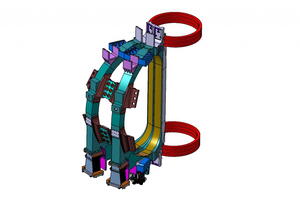Coping with extreme stress
ITER will be the biggest tokamak built so far. The electromagnetic forces acting on the machine structure during operation will be huge—to the order of several hundred meganewtons (MN). In order to cope with the out-of-plane forces caused by electromagnetic interaction between the toroidal field coil current and the magnetic field generated by the poloidal field coils, pre-compression rings will be installed to pre-compress the poloidal keys at the top and bottom of the inner straight leg of the toroidal field coils with a centripetal force of 32MN. This will suppress any gap opening and greatly reduce any cyclic fatigue stresses.
But what material would hamper the induced currents and withstand the high loads? A thorough study of possible alternatives was carried out at the Ente per le Nuove Tecnologie, l'Energia e l'Ambiente (ENEA) in Frascati, Italy, and the most suitable material turned out to be S2 glass-fiber/epoxy composite. More recently, a mockup compression ring one fifth the original size was manufactured following vacuum pressure impregnation techniques. By using this technique, it is possible to reach over 60 percent glass content in the composite which results in a stiffness of over 50 gigapascale (GPa): four times lower than that of steel which would accommodate machine settling effects.
On 28 January this year, a rupture test was carried out reaching an amazing 1400 Megapascal (MPa) before breaking in a testing facility specifically prepared with this aim. This is more than a factor of three higher than the ITER design value of 440MPa. A large-scale testing facility is now foreseen to be built for the qualification of the final rings. The Procurement Arrangement is scheduled to be signed this year.




